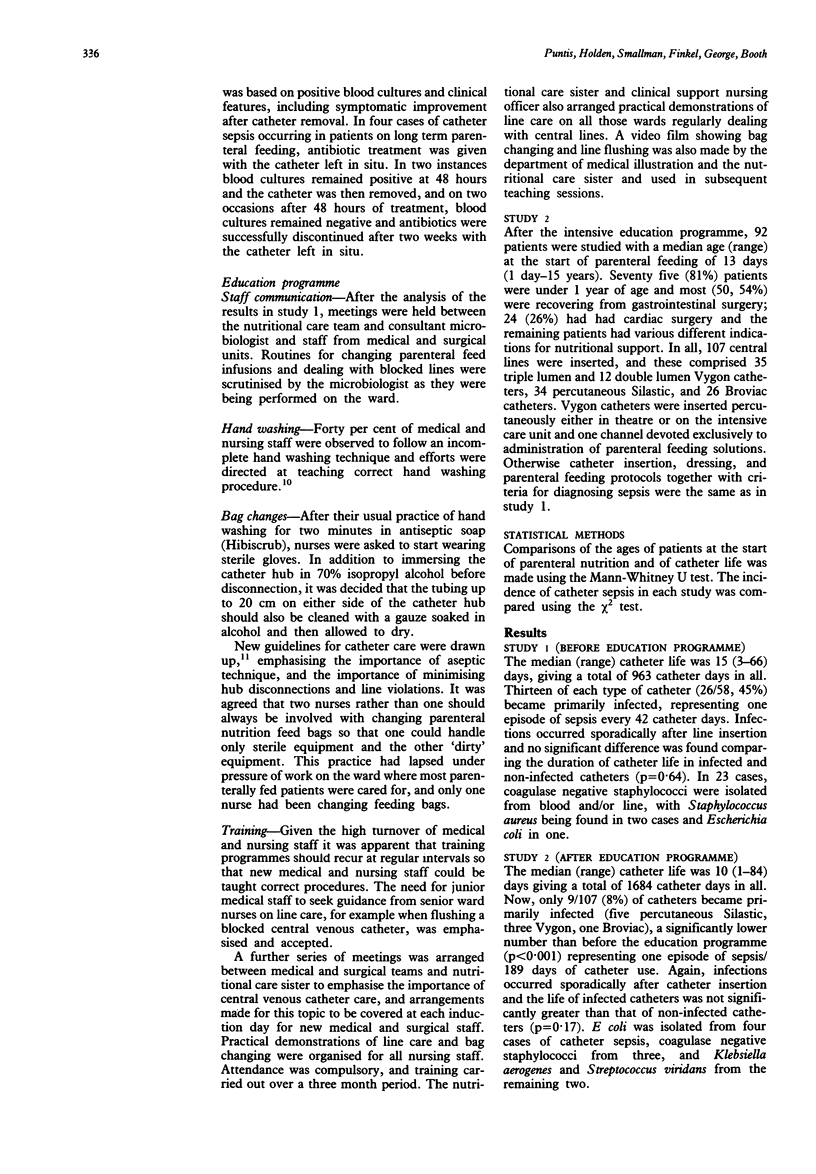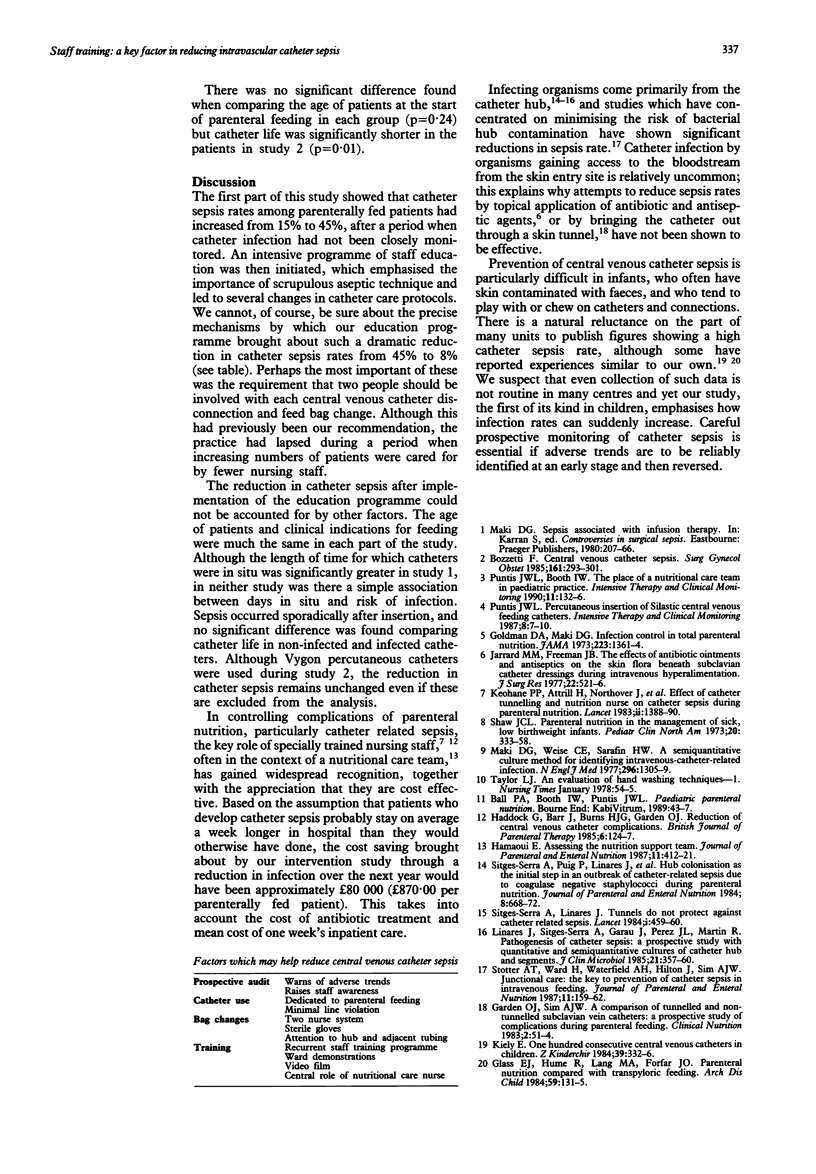Abstract
A children's hospital nutritional care team prospectively monitored the frequency of sepsis in central venous catheters used for administering parenteral nutrition. During an initial study period of 12 months, 26/58 (45%) of catheters were removed because of proved sepsis. The possible causes of this alarmingly high rate were examined, with catheter care techniques on the wards coming under particular scrutiny. As a result protocols were modified and an intensive staff training programme implemented throughout the hospital, led by the nutritional care sister. Subsequently, the catheter sepsis rate was significantly reduced with only 9/107 (8%) of consecutive catheters becoming infected. These findings emphasise the key role that education of staff plays in controlling central venous catheter sepsis and the importance and cost effectiveness of special nursing staff in implementing such measures.
Full text
PDF


Selected References
These references are in PubMed. This may not be the complete list of references from this article.
- Bozzetti F. Central venous catheter sepsis. Surg Gynecol Obstet. 1985 Sep;161(3):293–301. [PubMed] [Google Scholar]
- Garden O. J., Sim A. J. A comparison of tunnelled and nontunnelled subclavian vein catheters: a prospective study of complications during parenteral feeding. Clin Nutr. 1983 Apr;2(1):51–54. doi: 10.1016/0261-5614(83)90031-6. [DOI] [PubMed] [Google Scholar]
- Glass E. J., Hume R., Lang M. A., Forfar J. O. Parenteral nutrition compared with transpyloric feeding. Arch Dis Child. 1984 Feb;59(2):131–135. doi: 10.1136/adc.59.2.131. [DOI] [PMC free article] [PubMed] [Google Scholar]
- Hamaoui E. Assessing the Nutrition Support Team. JPEN J Parenter Enteral Nutr. 1987 Jul-Aug;11(4):412–421. doi: 10.1177/0148607187011004412. [DOI] [PubMed] [Google Scholar]
- Keohane P. P., Jones B. J., Attrill H., Cribb A., Northover J., Frost P., Silk D. B. Effect of catheter tunnelling and a nutrition nurse on catheter sepsis during parenteral nutrition. A controlled trial. Lancet. 1983 Dec 17;2(8364):1388–1390. doi: 10.1016/s0140-6736(83)90922-4. [DOI] [PubMed] [Google Scholar]
- Kiely E. One hundred consecutive central venous catheters in children. Z Kinderchir. 1984 Oct;39(5):332–336. doi: 10.1055/s-2008-1044238. [DOI] [PubMed] [Google Scholar]
- Liñares J., Sitges-Serra A., Garau J., Pérez J. L., Martín R. Pathogenesis of catheter sepsis: a prospective study with quantitative and semiquantitative cultures of catheter hub and segments. J Clin Microbiol. 1985 Mar;21(3):357–360. doi: 10.1128/jcm.21.3.357-360.1985. [DOI] [PMC free article] [PubMed] [Google Scholar]
- Maki D. G., Weise C. E., Sarafin H. W. A semiquantitative culture method for identifying intravenous-catheter-related infection. N Engl J Med. 1977 Jun 9;296(23):1305–1309. doi: 10.1056/NEJM197706092962301. [DOI] [PubMed] [Google Scholar]
- Sitges-Serra A., Linares J. Tunnels do not protect against venous-catheter-related sepsis. Lancet. 1984 Feb 25;1(8374):459–460. doi: 10.1016/s0140-6736(84)91800-2. [DOI] [PubMed] [Google Scholar]
- Sitges-Serra A., Puig P., Liñares J., Pérez J. L., Farreró N., Jaurrieta E., Garau J. Hub colonization as the initial step in an outbreak of catheter-related sepsis due to coagulase negative staphylococci during parenteral nutrition. JPEN J Parenter Enteral Nutr. 1984 Nov-Dec;8(6):668–672. doi: 10.1177/0148607184008006668. [DOI] [PubMed] [Google Scholar]
- Stotter A. T., Ward H., Waterfield A. H., Hilton J., Sim A. J. Junctional care: the key to prevention of catheter sepsis in intravenous feeding. JPEN J Parenter Enteral Nutr. 1987 Mar-Apr;11(2):159–162. doi: 10.1177/0148607187011002159. [DOI] [PubMed] [Google Scholar]


